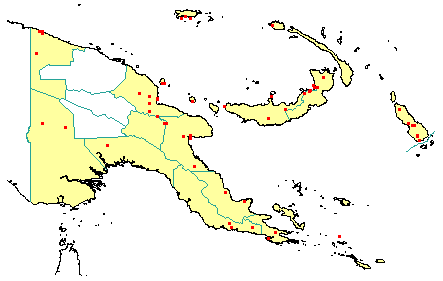
in PNGplants database
PNGTrees – Myristica inutilis subsp. papuana (Markgr.) W.J.de Wilde |
Barry Conn (NSW) & Kipiro Damas (LAE).
Copyright held by the authors, Royal Botanic Gardens and Domain Trust, and Papua New Guinea National Herbarium
Blumea Vol. 40(2): 239 (1995)
Other Literature: W.J.de Wilde, Flora Malesiana Vol. 14: (2000)
Field Characters: Large trees 25 m high. Bole cylindrical dbh 25 cm; straight 25 m long; buttresses absent spurred at base; spines absent; aerial roots absent; stilt roots absent. Bark brown, rough, slightly pustular or tessellated; lenticels irregular; subrhytidome red or brown; bark thickness <25 mm thick, 16.0 mm thick; blaze consisting of one layer; faintly to non-aromatic; pleasant; outer blaze red, markings absent, fibrous; inner blaze red, markings absent, fibrous; exudate present, red, flowing, not changing colour on exposure to air, sticky. Terminal buds not enclosed by leaves; complex hairs absent; stinging hairs absent; mature twig hairy; hairs dense.
Leaves: Spaced along branches <internodes readily visible>. Leaves spiral, simple; petiole present, not winged, attached to base of leaf blade <not peltate>, not swollen; lamina broadest above middle, 11.4-24.0 cm long, 2.5-7.0 cm wide; lamina symmetric, margin entire, not dissected or lobed, apex sub acuminate, venation pinnate <secondary veins arising from the midrib along its length>, secondary veins open <spaced far apart to easily see tertiary veins>, prominent, intramarginal veins absent; lower surface brown, upper surface green, hairs present, dense; oil dots absent; domatia absent; stipules absent.
Flowers: Inflorescence sub axillary <from between a leaf and branch> between or below leaves. Flowers on an unbranched axis (male flowers in umbell-like clusters of mostly 5-10 flowers or flowers on a branched axis 2 branched, rarely 3-branched; flowers unisexual, with male and female flowers on the same plant <monoecious>, flowers stalked 1-2 mm long (female flowers), 2-5 mm long (male flowers), with many planes of symmetry <actinomorphic>, 3.0-5.0 mm long, small (< or =10 mm diam.) (3-4 mm diam.); perianth present, with all sepals and/or petals (hence tepals) similar; inner perianth 3, some or partly joined; stamens 8-30, filaments present, joined <connate> to form a single column with joined anthers, free of perianth; ovary superior <seated above petals and sepals; hypogenous>, carpels solitary <monomerous>, locules 1; styles solitary <including joined together> (very short) or absent, 0-1.
Fruits: Fruits arranged on branched axis. Fruit 25-50 (-60) mm long, 15.0-30.0 mm diam., fruit pale orange or brown, not spiny, fleshy (leathery), simple, dehiscent, capsule splitting into 2 valves. Seeds 1 (brown to almost black), much more than 10 mm long about 25 mm long, not winged, longer than wide, >10 mm diam. about 15 cm diam.
Distribution: Milne Bay, Bougainville, Manus, New Ireland, New Britain, Papuan Islands, Northern, Central, Gulf, Western, Eastern Highlands, Morobe, West Sepik & Madang.
 | Botanical records in PNGplants database |
Notes: Two varieties are recognised by De Wilde (2000) Flora Malesiana Vol. 14, namely var. formanniana W.J. de Wilde and var. papuana. The former variety has leaves up to 30 cm long, 9 cm wide and fruits 50-55 mm long, about 50 mm diam., with pericarp about 10 mm thick; var. papuana has leaves 11-24 cm long, 2.5-7 mm wide and fruits 25-50(-60) mm long, with pericarp (1-)2-5 mm thick. The description provided here is based on the widespread var.papuana.